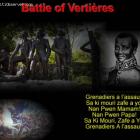ADVERTISEMENT
Haitian Art - Haiti Observer Blog
Haitian Art, Haiti Observer Blog. Read the following articles about Haitian Art
Recycled Metal Art in Haiti
A unique type of art in Haiti is the Haitian metal art. This form of art involves the re-use of used oil drums for art work.
Steel oil drums once have been emptied are bought from the port near Port Au Prince and taken to the town of Croix-des-Bouquets which neighbors the Haitian capital. Here the process of recycling the used drums begins.
First the round ends of the used drum are removed and the drum is set on fire to remove paint and any form of residue. The cylindrical drum is then cut top down and flattened. The flat metal canvas measures about 3 x 6 inches. A chalk is used to make a drawing of the shape to be worked on the metal surface. The art is completed with primitive tools like chisels and hammers. The primitive piece of art is then signed by the artist and then covered with a protective coat.
Saint Soleil Art
Saint Soleil is an art school linked to Prospere Pierre-Louis. Prospere has his roots in Bainet a town in the south of Haiti. After his birth in 1947 he grew to love drums and the violin. His father houngan also engaged him in voudou ritual ceremonies.
Despite his lack of school education, the boy practiced shaving and worked as barber at the age of 16. His painting destiny was shaped when he hooked up with Maud Robard.
In 1973 and while Prospere was working for Maud as a waiter, Maud organized a team of artists of different genres into a movement. Maud was working in collaboration with a Haitian legend artist Tiga. The movement was called Saint Soleil. Prospere joined the team under the influence of Maude.
Voodoo Flag, a unique Haitian art
Voodoo flags are a significant form of art that define the Haitian art industry. Haitian flags depict a combination of several African beliefs and cultures. Voodoo flags have the history of the enslavement of Africans in Haiti. The art also brings on board the influence of Catholicism and Jamaican and Cuban cultures.
The Caribbean country had colonizers French and Spain take over in 1600s. The two colonies improved economic activities in the region. Demand for slave workers increased and more slaves were brought in from Africa.
The slave numbers increased until they outnumbered the colonizers. The slaves staged the only organized and successful slave revolt which led to independence.
Primitive art of Haiti with an international reputation
Haitian art has grown to attain world recognition. This is an extra-ordinary fame for the so called the poorest of all the western countries.
Haitian art is termed as the best form of primitive art in the world. The industry gained ground in 1940 when an American teacher began to appreciate the uniqueness of Haitian art. Dewitt Peters was impressed by the talents that he discovered in many uneducated Haitians.
The people of Haiti create unique artistic materials which are based on raw colors. Dewitt established the Centre D'Art Haitian in 1943 an artistic centre to support and expose Haitian dedicated artists.
Papier Mache Art in Jacmel
Haiti remains the outstanding nation in terms of primitive art. The art industry in Haiti brings on board widely varied styles of painting.
One of the popular styles of art is Papier-mache. In making this, a wet surface is laid on a form. The surface is allowed to dry once the image is created. Distinctive colors are applied on the created image to add life and details. Haiti locals, artists and tourists have embraced this style of art.
Papier-mache has been used to create images for animals, vases, masks, political personalities etc.
Cap-Haitien Art
This is a form of art which dominates Cap-Haitien in the northern seacoast of Haiti. The pioneer of the type of art is Philome Obin a Haitian art legend.
Cap-Haitien form of art is characterized by linear elements and the artistic use of paints and brushtokes.
The unique art is based on the subject of the Haitian way of life, the people, the Haitian culture and the country's heritage.
The artworks of Haiti are globally recognized. The revolution began in 1944 after the established of Centre D' art Haitian in Port au Prince by the legend Dewitt peters an American teacher. The industry has since developed beyond imagination to become the best in primitive art in the world.
Artibonite Style of Art
Haiti has developed to become the home of primitive art. The art history dates back to 1940's when the Centre D'art was established by Dewitt peters in Port-Au-Prince.
The art revolution has seen the establishment of other several schools of art in Haiti. School of Cap-Haitian was founded by Philome Obin, Prefete Duffaut created the School of Jacmel, Foyer Des Arts Plastiques was established by Lucien Price and Cedor.
Another school of art is the Artibonite School linked to Saincilus Ismael who is the founder and considered as the father of a style of painting called Artibonite. Saincilus Ismael has contributed much to the evolution of art in Haiti.
Croix Des Bouquets and The 2010 Earthquake impact
The residential town of Croix Des Bouquets in the Ouest Department used to be clean, peaceful and glamorous. Even if a deadly earthquake rattled the entire country in 2010, Croix Des Bouquets retained its glamour as it was not as affected as the capital of Port-au-Prince. However, the aftermath of the earthquake eventually became destructive and detrimental to Croix Des Bouquets.
As survivors fled Port-au-Prince to seek shelter in other towns and cities, refugees thronged to Croix Des Bouquets. This resulted in a period of chaos, as people continued to come to the town. People began setting up tents for shelters and merchants started to scatter all around. This made the town untidy and unruly, which was such a waste because a lot of developmental programs have been done in the area to keep it clean, peaceful and orderly.
Ganthier And Its Tourism Potential
If there is one place in Haiti where tourists may want to visit, it can be the town of Ganthier in the Arrondissement of Croix-des-Bouquets. The town has a lot of great stuff to offer to tourists. It is known for the production of Haiti arts such as crafts, handiworks and others. There is actually a tourist shop where people can buy souvenirs. Tourists are also fond of Ganthier's environs, as well as the l'étang Saumâtre located near by.
In addition to the regular tourists flocking the city are the pilgrims who arrive every year. Thousands of natives and pilgrims come to Ganthier to visit a holy site called the Calvaire Miracle. Most of the pilgrims are Catholic and Voodoo followers who pray and wish to get rid of their problems and start a new life. In order to signify the challenges and burden they carry, the pilgrims hold stones over their heads.
Return of Serment des Ancetres Painting To Haiti
After two years when relations with France were restored, Michel Martelly, President accompanied by Laurent Lamothe, Prime Minister, Didier Lebret, France Ambassador and Jean Mario Dupuy, Minister of Culture, all got together last Friday to welcome the Serment des Ancêtres painting
Symbolism of the Painting
They were welcomed to the table on which lay 'Serment des Ancetres' at the airport Toussaint Louverture's diplomatic lounge. The 'Serment des Ancetres' is the painting work of Guillaume Guillon-Lethiere (1760 -1830) painter in the year 1822.
The painting symbolizes the historical meeting between Lieutenant Toussaint Louverture, Jean-Jacques Dessalines, Black General, Alexandre Petion and Saint Domingue, the head of mullattoes. In November 1802, the Lieutenant Toussaint Louverture sealed an alliance to get the French troops ousted.
Our objective is to share with you news and information about Haiti and the people of Haiti. Traditions, habits and the way we were or grew are alive in this site. We highly recommend that you Subscribe to our Newsletter and also share with us some of the things that are memorable and made us unique people.

 Thomassique, Haiti
Thomassique, Haiti  Saint Michel de L 'Atalaye
Saint Michel de L 'Atalaye  Informative Marketing and Advertising in the Haitian Community
Informative Marketing and Advertising in the Haitian Community  Battle of Vertieres
Battle of Vertieres  Black Friday Shopping Season
Black Friday Shopping Season